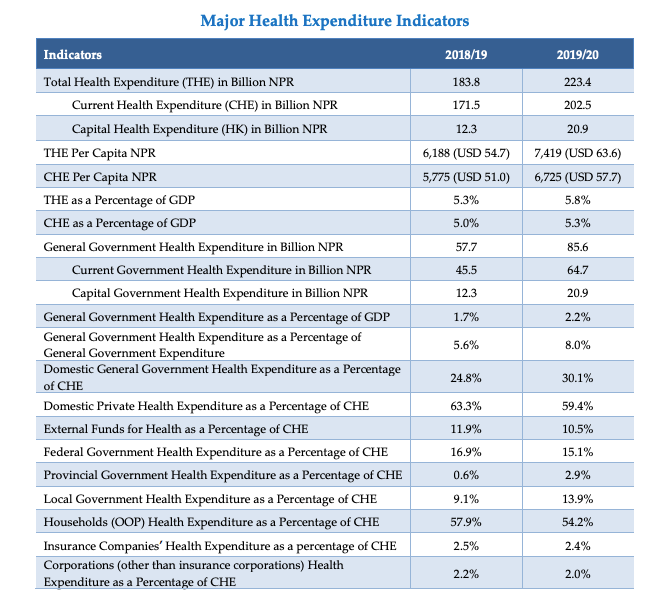This is the eighth round of Nepal National Health Accounts based on the System of Health Accounts (SHA) 2011 Framework, covering FYs 2018/19 and 2019/20.
The Nepal National Health Accounts 2018/19 to 2019/20 report was prepared adhering to the System of Health Accounts 2011 (SHA 2011), a global standard framework for producing health accounts with necessary refinements relevant to the country context. The report provides estimates of healthcare expenditures within Nepal’s health system, utilizing predetermined expenditure boundaries, data sources, classification codes, and estimation methodology. All reasonable precautions have been taken to justify the information presented in this publication, and the estimates presented in this report could be further improved.
- In this round of NHA, current health expenditure (CHE) in nominal prices was estimated at NPR 171.5 billion and NPR 202.5 billion and capital expenditure at NPR 12.3 billion and NPR 20.9 billion in FYs 2018/19 and 2019/20, respectively.
- Total Health Expenditure (THE) was estimated at NPR 183.8 billion (USD 1.6 billion) and NPR 223.43 billion (USD 1.9 billion), equivalent to 5.3% and 5.8% of GDP, and per capita total health expenditure was estimated at NPR 6,188.4 (USD 54.7) and NPR 7418.8 (USD 63.6) in FYs 2018/19 and 2019/20, respectively.
- General Government Health Expenditure (GGHE), including current and capital expenditure, amounted to NPR 57.7 billion (USD 0.5 billion) and NPR 85.6 billion (USD 0.7 billion), which were 5.6% and 8.0% of General Government Expenditure (GGE) in the FYs 2018/19 and 2019/20, respectively.
- The share of GGHE in CHE increased from 26.5% in FY 2018/19 to 31.9% in FY 2019/20. At the federal level, the Ministry of Health and Population (MoHP) was the largest agency for managing government health expenditure, accounting for about 24.5% of GGHE, followed by provincial and local governments with about 0.6% and 9.1%, and other ministries and public bodies with 8.1% in FY 2018/19. Curative care accounted for the largest share of government health expenditure, followed by preventive care.
- Total external funding for health was estimated at 11.9% and 10.5% of CHE in the FYs 2018/19 and 2019/20, which includes direct foreign transfers and foreign transfers distributed for health through the government.
Household OOP payments for health care were the largest source and payer for their health care, with a share of 57.9% and 54.2% of the current health expenditure in FYs 2018/19 and 2019/20, respectively.
- As much as 65.6% of OOP payments for health care were for pharmaceuticals and medical supplies, followed by curative care at 26.3%.
- OOP at hospitals was estimated at 20.8% of total OOP, where the majority (16.6% of total OOP) was made at private hospitals, and the OOP at public hospitals was 4.2% of total OOP.
- An analysis of disease-related expenditure shows that non-communicable diseases accounted for more than half of total household OOP expenditure.
- As much as 41.1% and 39.9% of CHE were spent on pharmaceuticals and medical supplies in FYs 2018/19 and 2019/20, respectively, while curative care took up about 29.8% and 33.4% of CHE, where around 18.9% and 22.1% of CHE and 10.2 and 10.6% of CHE were spent on outpatient and inpatient care, respectively.
Preventive and promotive care services claimed about 8.8% and 11.0% of CHE,FYs 2018/19 and 2019/20 respectively.
- The distribution of health expenditure by province showed that Bagmati Province had the highest share of current and capital health expenditure, with provincial THE estimated at NPR 51.1 billion, followed by Koshi Province and Lumbini Province with provincial THE of NPR 30.5 billion and NPR 28.5 billion, respectively, in FY 2018/19, while in FY 2019/20 THE of Bagmati Province was 60.3 billion. Karnali Province had the lowest provincial THE, estimated at NPR 13.4 and 17.1 billion in FYs 2018/19 and 2019/20, respectively.

- Nepal National Health Accounts 2017/18
- Nepal National Health Accounts 2016/17
- Progress of the Health and Population Sector, 2020/21 (NJAR Report)
- Dissemination of Findings and Recommendations of Joint External Monitoring Mission(JEMM) of Nepal National Tuberculosis Program
- Emergency Contraceptive Pills (ECP) Program Implementation Guideline 2078
- National Standards on WASH for Health Institutions 2078
- Pocket Book of Clinical Management of COVID-19 in Healthcare Setting: 2nd Edition with Revision
- Tuberculosis Free Nepal Declaration Initiative Implementation Guideline


